Experimental Study on the Performance of Graded Glass Fiber Reinforced Concrete (G-GRC) Based on Engineering Application
Abstract
1. Introduction
2. Test Materials and Methods
2.1. Test Material and Specimen Preparation
2.2. Test Scheme
2.2.1. Compatibility Design
2.2.2. Experimental Group Design
2.2.3. Test Method
3. Experimental Results and Analysis
3.1. Analysis of CS Test Results
3.2. Analysis of TS Test Results
3.3. Analysis of FS Test Results
3.4. Analysis of IP Test Results
4. Engineering Applications
4.1. Overview of Laoshan Tunnel Project
4.2. Application and Effect Analysis of G-GRC
5. Conclusions
- (1)
- Although the TS, FS, and IP of G-GRC were significantly enhanced, the CS decreased slightly. The grade ARGF admixture has less effect on the CS of concrete, and the decreasing value of CS remains stable, while with the augmentation of grade ARGF admixture, the TS, FS, and IP displayed trends of first increasing and then decreasing. When the contents of HD and HP ARGFs are 0.6 and 5 kg/m3, the bridging and cracking effects of ARGFs are the most apparent, and the overall index performance of concrete is the best.
- (2)
- The ESRs of the CS, TS, and FS of G-GRC were all improved. For TS and FS, the ESRs increased while the TS and FS of G-GRC at all ages increased. In contrast, for CS, the ESR increased while the CS of G-GRC at all ages was reduced by different degrees. As a result, the increase in the ESRs of concrete cannot represent the improvement in the mechanical properties.
- (3)
- According to the compression and tensile tests, owing to the substantial increase in the TS, the TCR of G-GRC was significantly improved. The TCR of G-GRC in the best-graded case is increased by 22.29% compared with that of ordinary concrete, which effectively avoids the problem of unforeseen crumbling damage of concrete due to brittleness.
- (4)
- Experimental research on ARGF concrete was successfully applied to the construction of the Laoshan Tunnel in Qingdao, China, and achieved a good application outcome, effectively improving the quality of the project while controlling the project cost.
6. Discussion
Author Contributions
Funding
Institutional Review Board Statement
Informed Consent Statement
Data Availability Statement
Conflicts of Interest
Nomenclature
| ARGF | Alkali-resistant glass fiber |
| HD-ARGF | High-dispersion alkali-resistant glass fiber, an engineered alkali-resistant short-cut fiber that can be well-dispersed in fresh concrete |
| HP-ARGF | High-performance alkali-resistant glass fiber, a type of engineered alkali-resistant short-cut fibers composed of single filaments glued together to form a strand |
| G-GRC | Graded glass fiber reinforced concrete, comprising different types of ARGFs mixed into the concrete in a certain ratio |
| CS | Compressive strength |
| TS | Tensile strength |
| FS | Flexural strength |
| IP | Impervious performance |
| PH | Penetration height |
| TCR | Tension–compression ratio |
| ECSR | Ratio of CSs after 3 and 180 d for each experimental group; the early strength ratio of CS |
| ETSR | Ratio of TSs after 3 and 180 d for each experimental group; the early strength ratio of TS |
| EFSR | Ratio of FSs after 3 and 28 d for each experimental group; the early strength ratio of FS |
| The nominal total area of cracks | |
| The nominal total crack area of a partition wall in ordinary concrete | |
| Nominal total crack area of partition wall in graded glass fiber reinforced concrete | |
| Reduction factor of concrete crack |
References
- He, J.H. Experimental Investigation on Shrinkage and Cracking Property in Glass Fiber-mortar. Master’s Thesis, Guangzhou University, Guangzhou, China, 2019. [Google Scholar]
- Wu, H.J.; Zhao, J.; Wang, Z.C.; Song, T. Damage action of alkali-resistant glass fiber in cement-based material. J. Wuhan Univ. Technol. Mater. Sci. Ed. 2013, 28, 761–765. [Google Scholar] [CrossRef]
- Eiras, J.N.; Kundu, T.; Bonilla, M.; Paya, J. Nondestructive Monitoring of Ageing of Alkali Resistant Glass Fiber Reinforced Cement (GRC). J. Nondestruct. Eval. 2013, 32, 300–314. [Google Scholar] [CrossRef]
- Holubova, B.; Hradecka, H.; Netusilova, M.; Gavenda, T.; Helebrant, A. Corrosion of Glass Fibres in Ultra High Performance Concrete and Normal Strength Concrete. Ceram. Silik. 2017, 61, 319–326. [Google Scholar] [CrossRef]
- Yang, S.T.; Yu, M.; Dong, K.; Yang, Y.S. Properties of Alkali-Resistant Glass Fiber Reinforced Coral Aggregate Concrete. Materials 2020, 13, 3450. [Google Scholar] [CrossRef]
- Tassew, S.T.; Lubell, A.S. Mechanical properties of glass fiber reinforced ceramic concrete. Constr. Build. Mater. 2014, 51, 215–224. [Google Scholar] [CrossRef]
- Shi, Z.Y.; Wang, Q.B.; Xu, L. Experimental Study of Cement Alkali-Resistant Glass Fiber (C-ARGF) Grouting Material. Materials 2020, 13, 605. [Google Scholar] [CrossRef]
- Wang, D.L.; Hao, B.Y.; Liang, X.M. Slurry diffusion of single fracture based on fluid-solid coupling. J. Min. Strat. Control. Eng. 2021, 3, 013038. (In Chinese) [Google Scholar]
- Zhang, C.; Song, W.D.; Fu, J.X. Technology for roadway management of fractured rock masses in a submarine gold mine. J. Min. Strat. Control Eng. 2020, 2, 033039. (In Chinese) [Google Scholar]
- Tian, C.L.; Yang, X.L.; Sun, H.T.; Liu, Y.B.; Hu, Q.T. Experimental study on the overburden movement and stress evolution in multi-seam mining with residual pillars. Energy. Sci. Eng. 2019, 7, 3095–3110. [Google Scholar] [CrossRef]
- Tian, C.L.; Liu, Y.B.; Yang, X.L.; Hu, Q.T.; Wang, B.; Yang, H.M. Development characteristics and field detection of overburden fracture zone in multiseam mining: A case study. Energy. Sci. Eng. 2020, 8, 602–615. [Google Scholar] [CrossRef]
- Nourredine, A. Influence of curing conditions on durability of alkali-resistant glass fibres in cement matrix. Bull. Mater. Sci. 2011, 34, 775–783. [Google Scholar] [CrossRef]
- Moceikis, R.; Karpova, E.; Kicaite, A.; Skripkiunas, G. Effect of Aggregates on the Technological and Mechanical Properties of Glass and Basalt Fibres Reinforced Concrete. In Proceedings of the 3rd World Multidisciplinary Civil Engineering, Architecture, Urban Planning Symposium (WMCAUS), Prague, Czech Republic, 18–22 June 2018. [Google Scholar]
- Wang, W.C.; Wang, H.Y.; Chang, K.H.; Wang, S.Y. Effect of high temperature on the strength and thermal conductivity of glass fiber concrete. Constr. Build. Mater. 2020, 245, 118387. [Google Scholar] [CrossRef]
- Liu, J.L.; Jia, Y.M.; Wang, J. Experimental Study on Mechanical and Durability Properties of Glass and Polypropylene Fiber Reinforced Concrete. Fibers Polym. 2019, 20, 1900–1908. [Google Scholar] [CrossRef]
- Prathipati, S.R.R.T.; Rao, C.B.K. A study on the uniaxial behavior of hybrid graded fiber reinforced concrete with glass and steel fibers. Mater. Today Proc. 2020, 32, 764–770. [Google Scholar] [CrossRef]
- Wang, T.; Zhang, J.H.; Bai, W.F.; Hao, S.M. Forming process and mechanical properties of fibers-reinforced polymer concrete. J. Reinf. Plast. Compos. 2013, 32, 907–911. [Google Scholar] [CrossRef]
- Wu, F.; Liu, C.W.; Diao, Z.F.; Feng, B.; Sun, W.; Li, X.L.; Zhao, S. Improvement of Mechanical Properties in Polypropylene- and Glass-Fibre-Reinforced Peach Shell Lightweight Concrete. Adv. Mater. Sci. Eng. 2018, 2018, 11. [Google Scholar] [CrossRef]
- Noh, J.Y.; Sung, C.Y. Engineering Properties of Carbon Fiber and Glass Fiber Reinforced Recycled Polymer Concrete. J. Korean Soc. Agric. Eng. 2016, 58, 21–27. [Google Scholar]
- Algburi, A.H.M.; Sheikh, M.N.; Hadi, M.N.S. Mechanical properties of steel, glass, and hybrid fiber reinforced reactive powder concrete. Front. Struct. Civ. Eng. 2019, 13, 998–1006. [Google Scholar] [CrossRef]
- CECS 13. Standard Test Methods for Fiber Reinforced Concrete; China Engineering Construction Association: Beijing, China, 2009. [Google Scholar]
- DLT 5148-2012. Technical Specification for Cement Grouting Construction of Hydraulic Structures; National Energy Administration: Beijing, China, 2012.
- DL/T 5150-2017. Test Code for Hydraulic Concrete; National Energy Administration: Beijing, China, 2017.
- JTG E30-2005. Test Methods of Cement and Concrete for Highway Engineering; Ministry of Communications: Beijing, China, 2005.
- GB/T 50081-2019. Standard for Test Methods of Concrete Physical and Mechanical Properties; Ministry of Housing and Urban-Rural Development and State Administration for Market Regulation: Beijing, China, 2019. [Google Scholar]
- Zhang, B.L.; Shen, B.T.; Zhang, J.H. Experimental study of edge-opened cracks propagation in rock-like materials. J. Min. Strat. Control Eng. 2020, 2, 033035. (In Chinese) [Google Scholar]
- Li, L.F.; Zhang, X.H.; Deng, H.L. Mechanical properties and energy evolution of sandstone subjected to uniaxial compression with different loading rates. J. Min. Strat. Control Eng. 2020, 2, 043037. (In Chinese) [Google Scholar]
- ASTM C1018-98. Standard Test Method for Flexural Toughness and First Crack Strength of Fiber-Reinforced Concrete: Using Beam with Third-Point Loading; American Society for Testing and Materials: West Conshohocken, PA, USA, 1998. [Google Scholar]
- JCI-S-001-2003. Method of Test for Fracture Energy of Concrete by Use of Notched Beam; Japan Concrete Institute: Tokyo, Japan, 2003. [Google Scholar]
- ASTM C1581-04. Standard Test Method for Determining Age at Cracking and Induced Tensile Stress Characteristics of Mortar and Concrete under Restrained Shrinkage; American Society for Testing and Materials: West Conshohocken, PA, USA, 2004. [Google Scholar]
- GB/T 50082-2009. Standard for Test Methods of Long-Term Performance and Durability of Ordinary Concrete; Ministry of Housing and Urban-Rural Development and State Administration of Quality Supervision and Inspection: Beijing, China, 2009.
- DL/T 5151-2014. Code for Testing Aggregates of Hydraulic Concrete; National Energy Administration: Beijing, China, 2014.
- Wu, P.; Li, L. Study on mechanical properties and fatigue damage of glass fiber reinforced lightweight aggregate concrete. China Concr. Cem. Prod. 2014, 9, 52–55. [Google Scholar]
- CECS 38. Technical Specification for Fiber Reinforced Concrete Structures; China Planning Publishing House: Beijing, China, 2004.
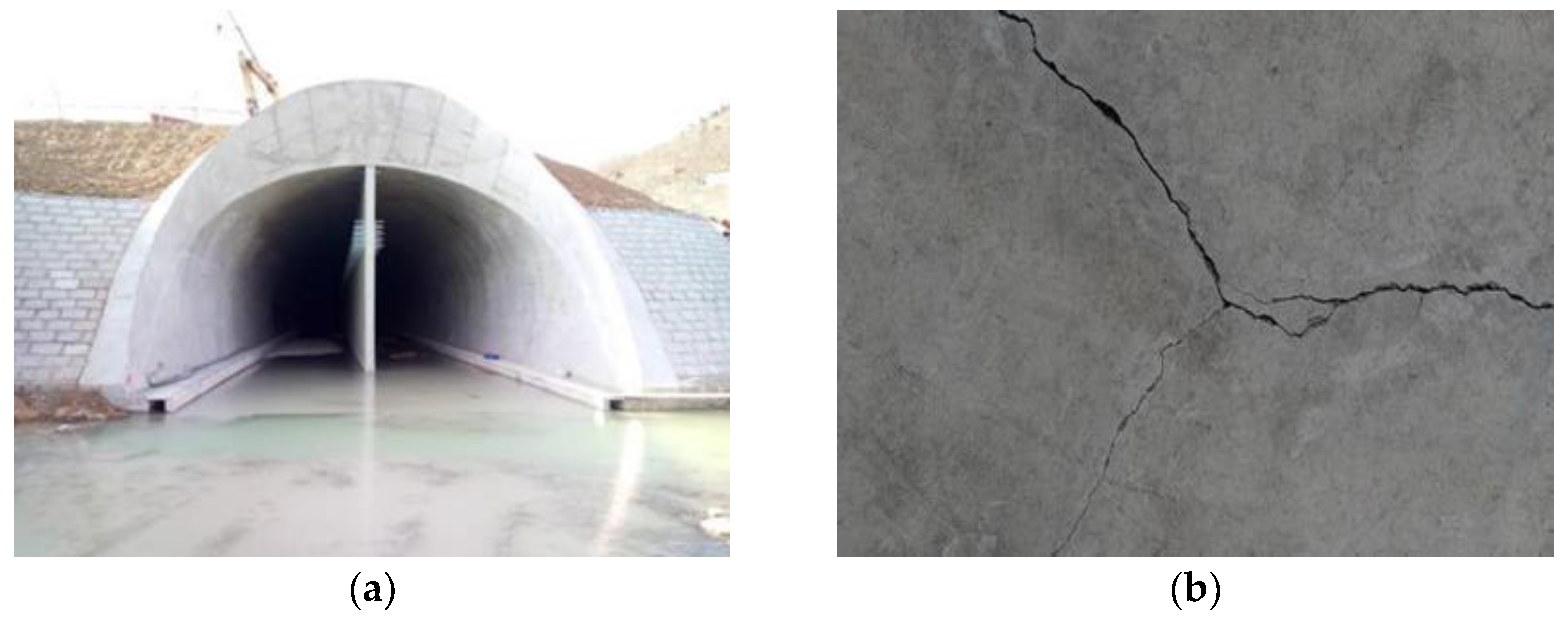
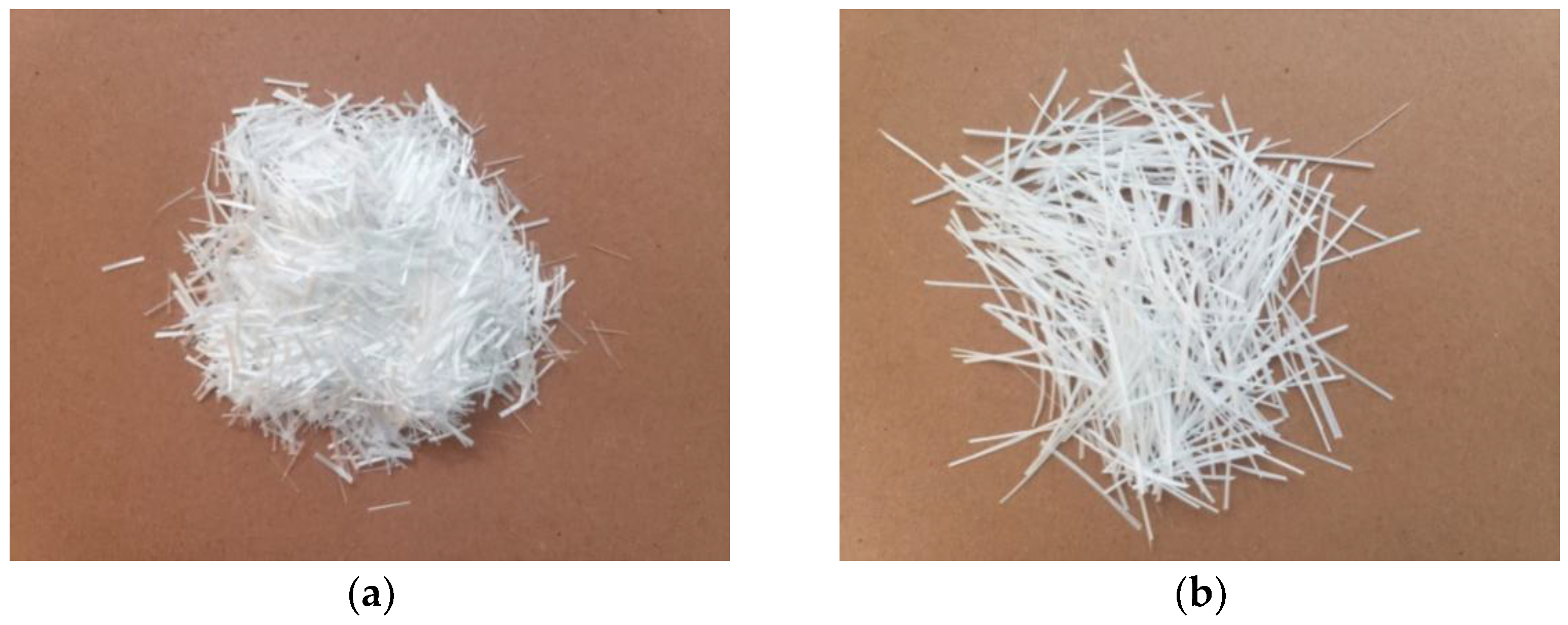

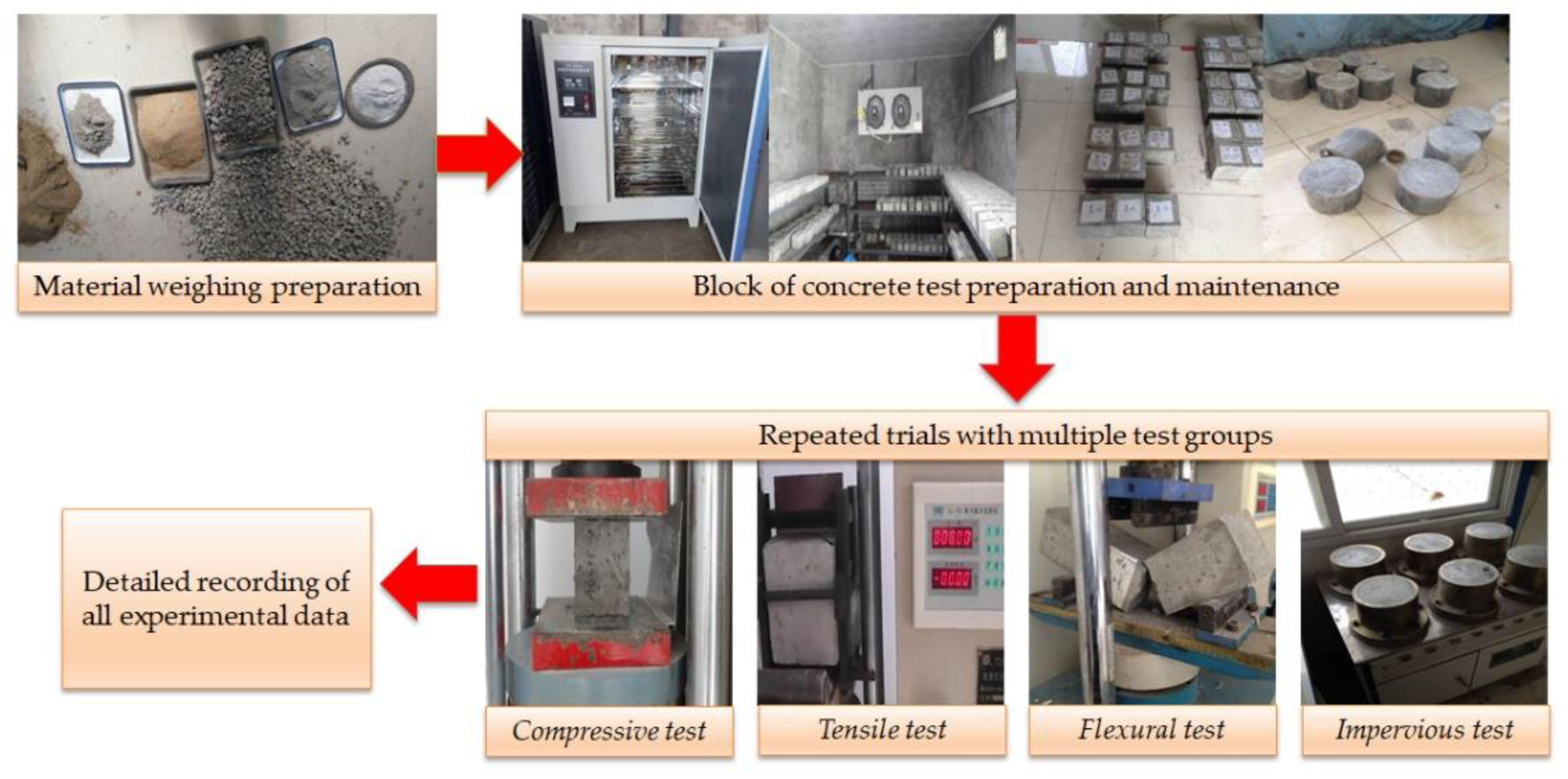
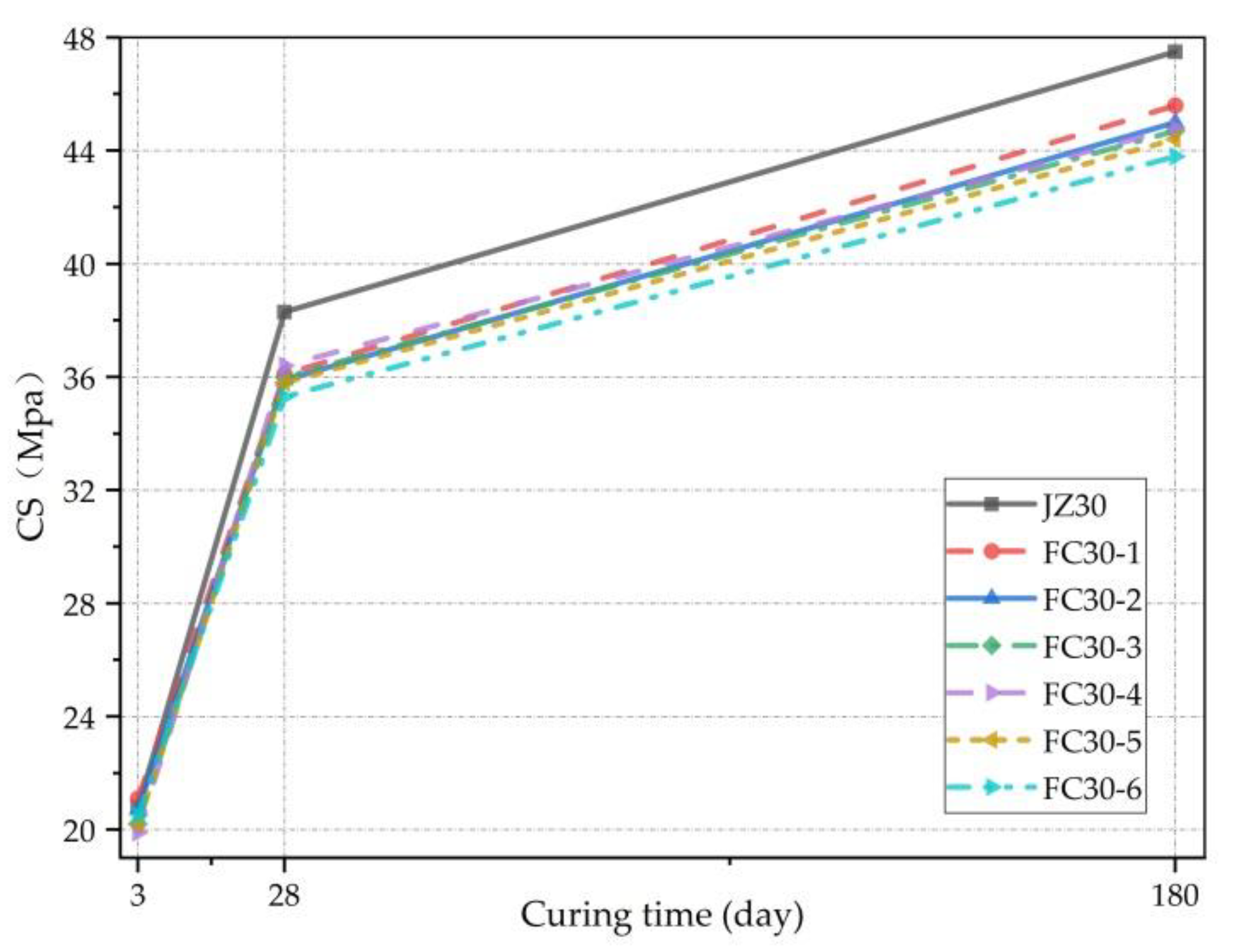
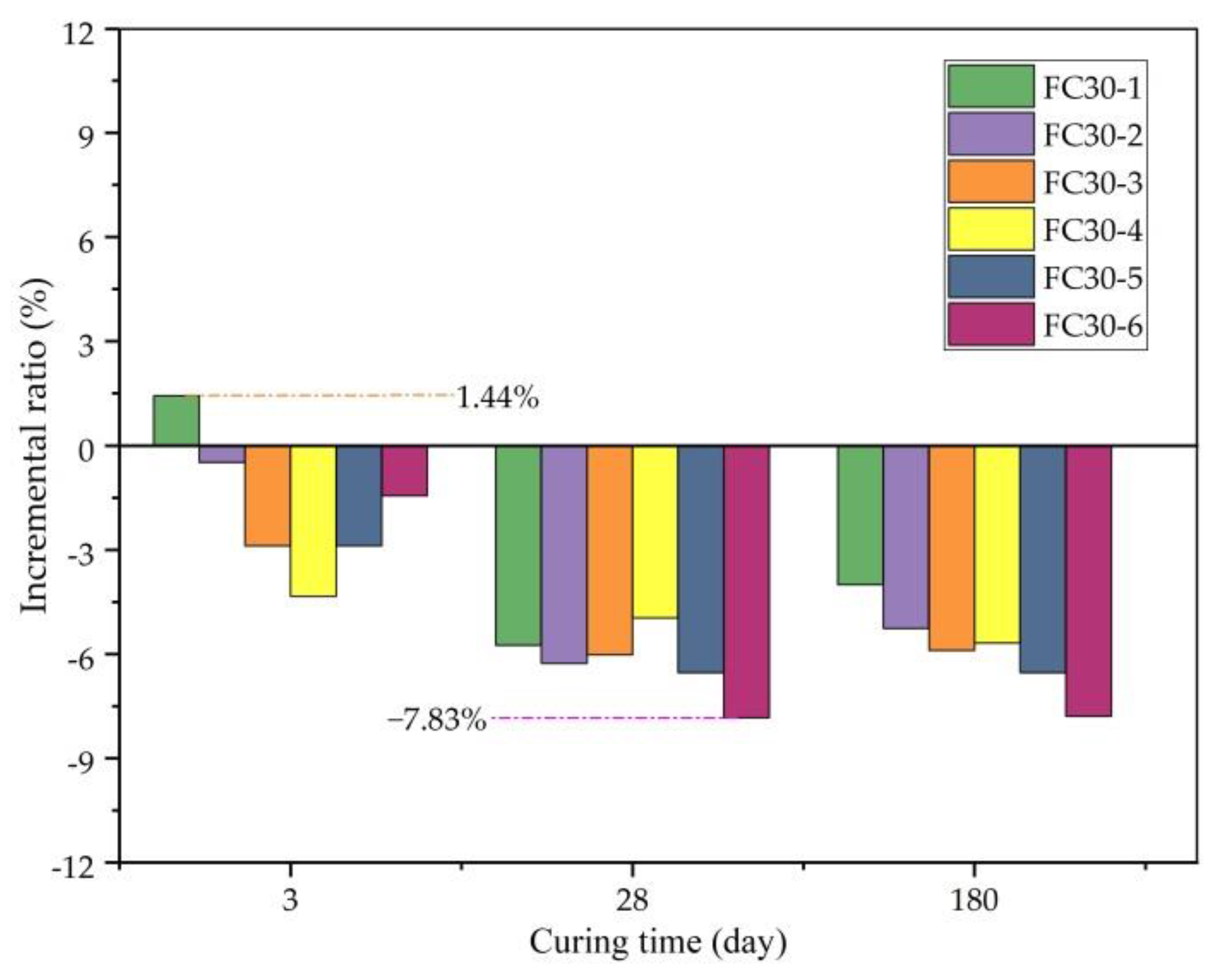
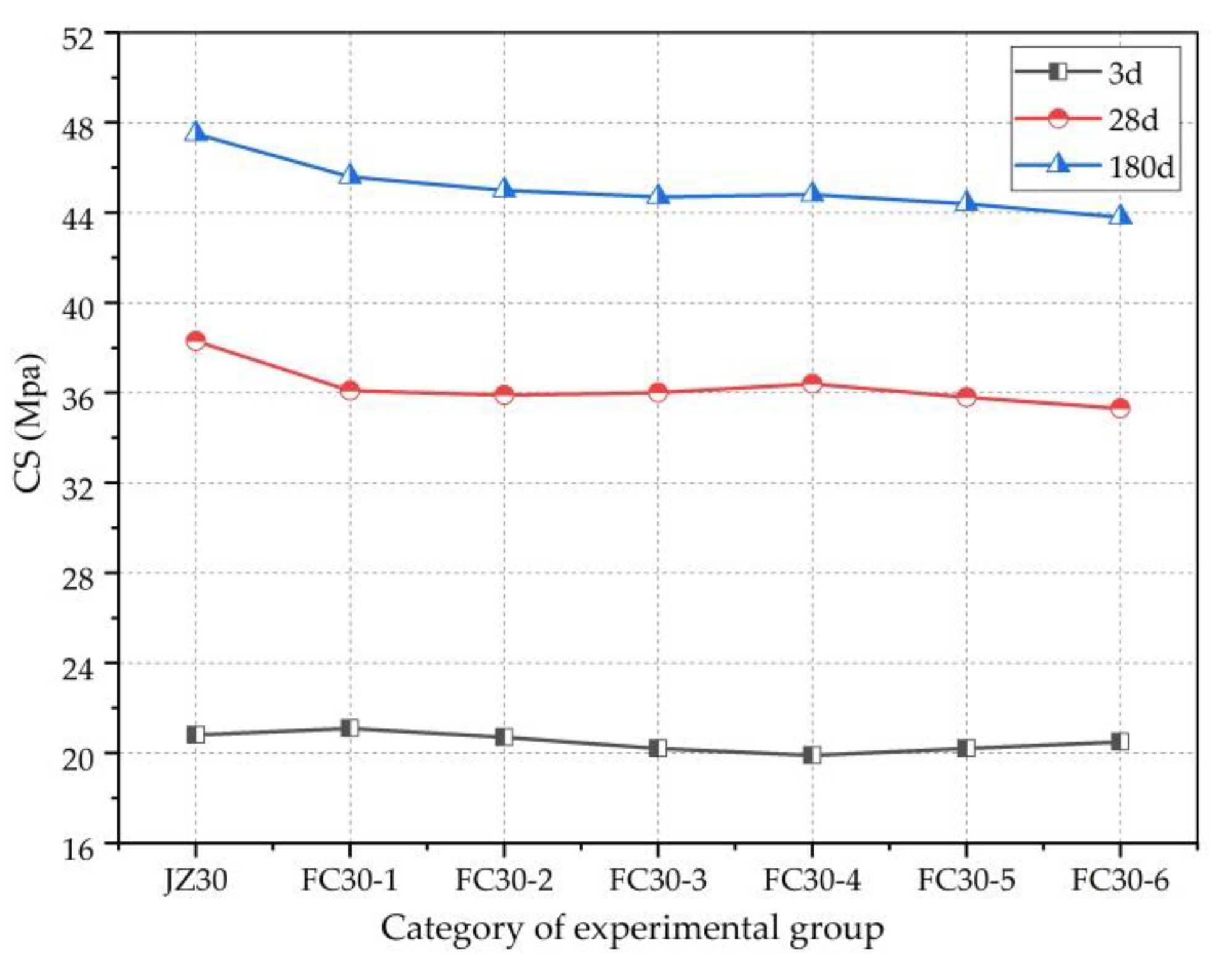
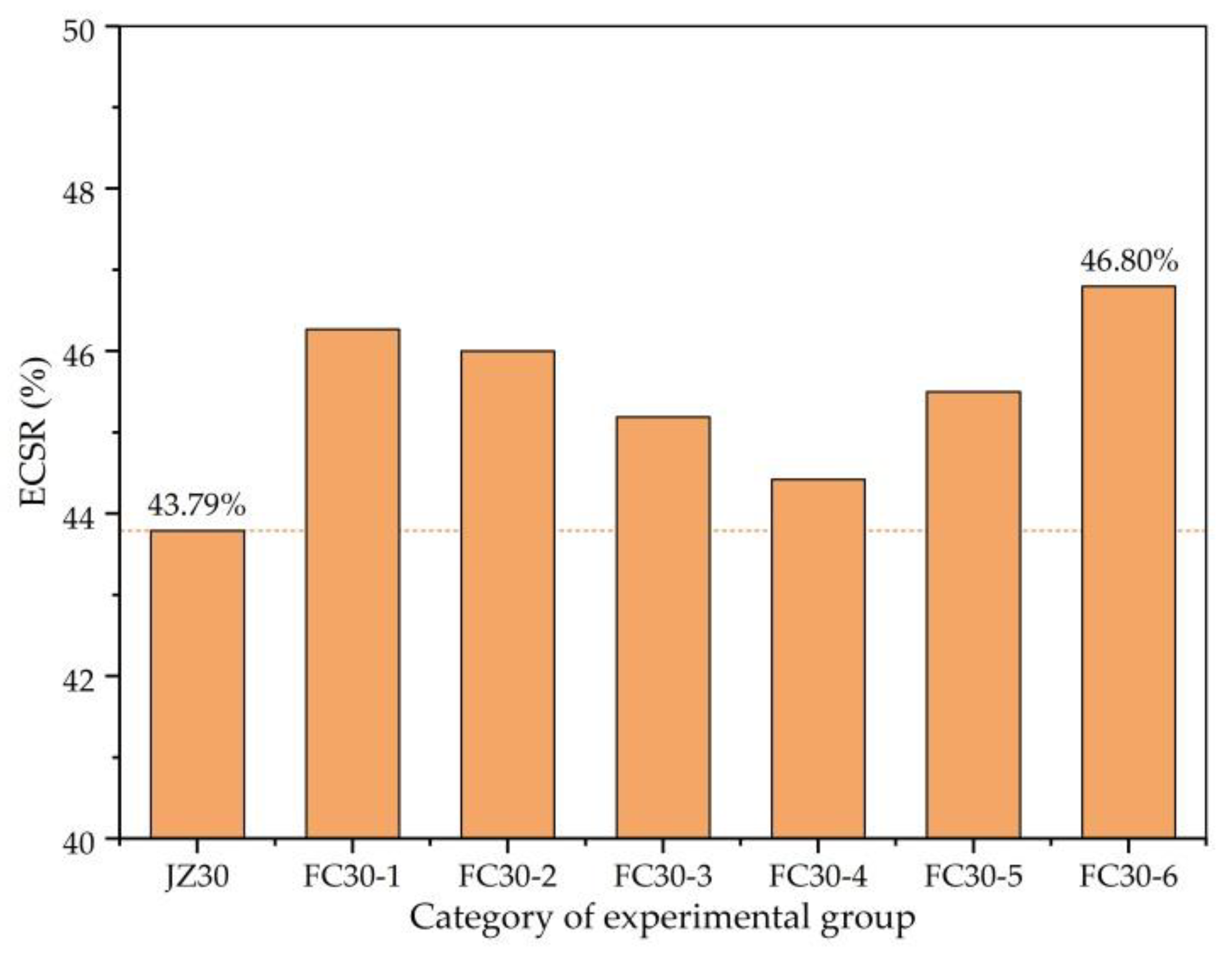
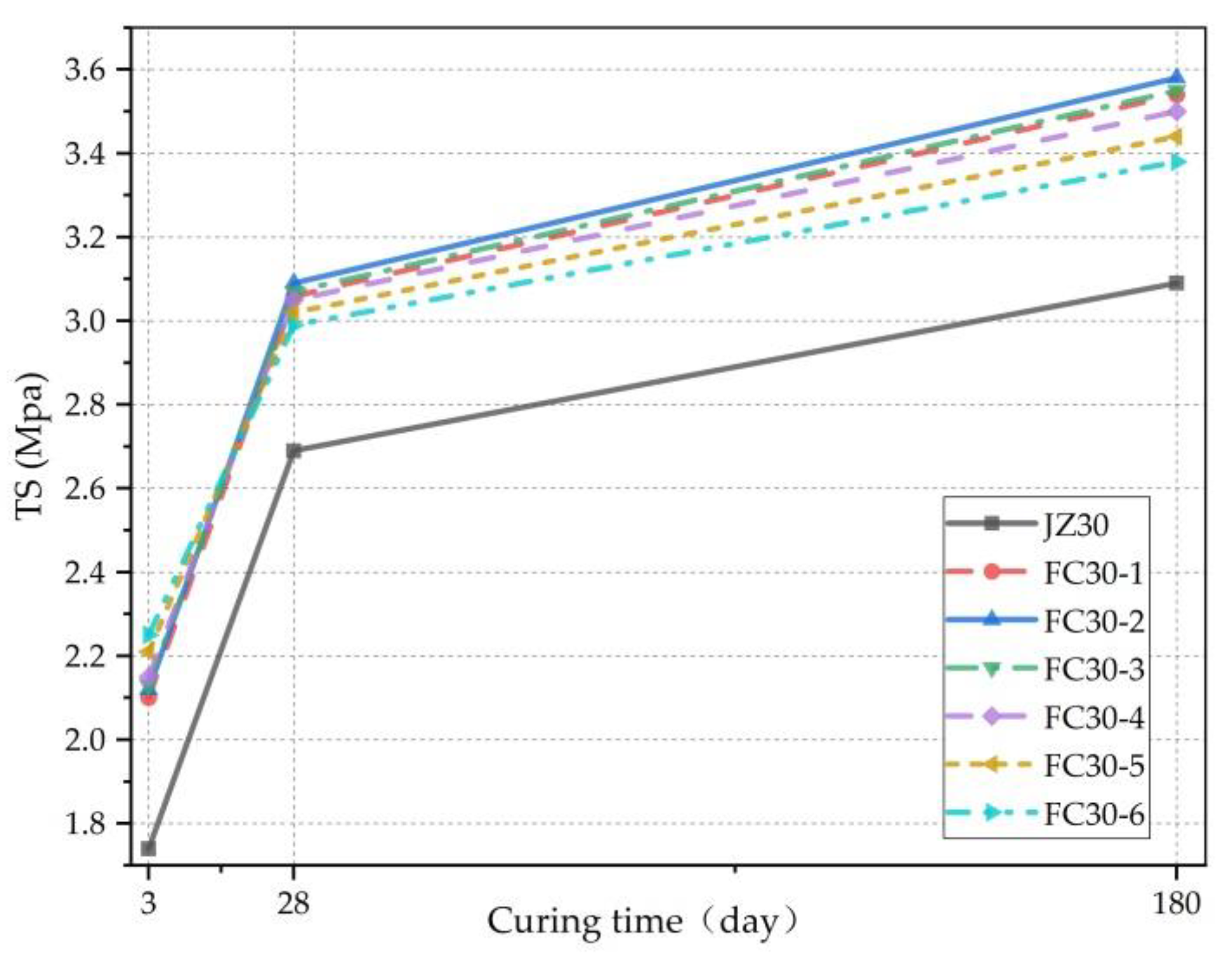
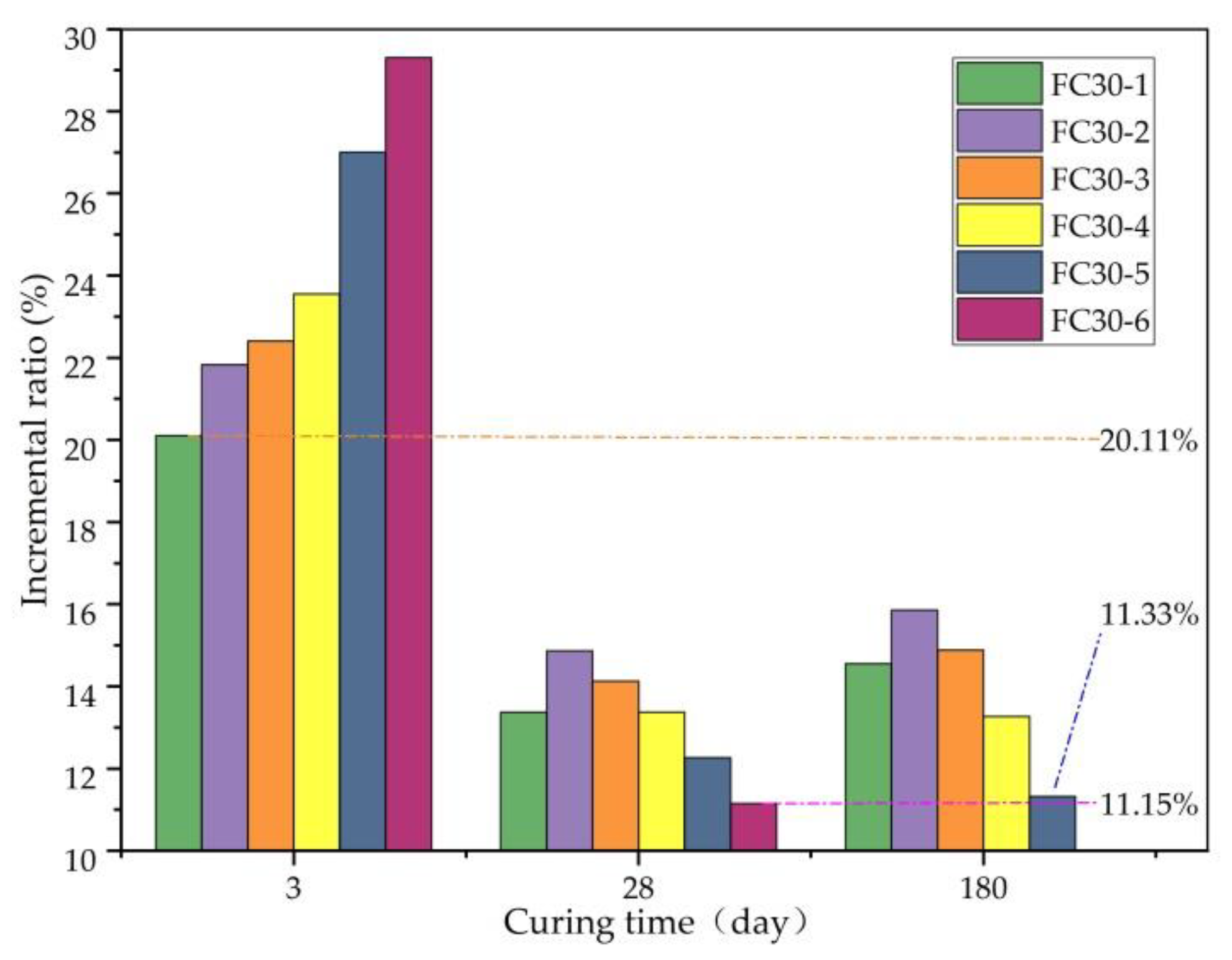
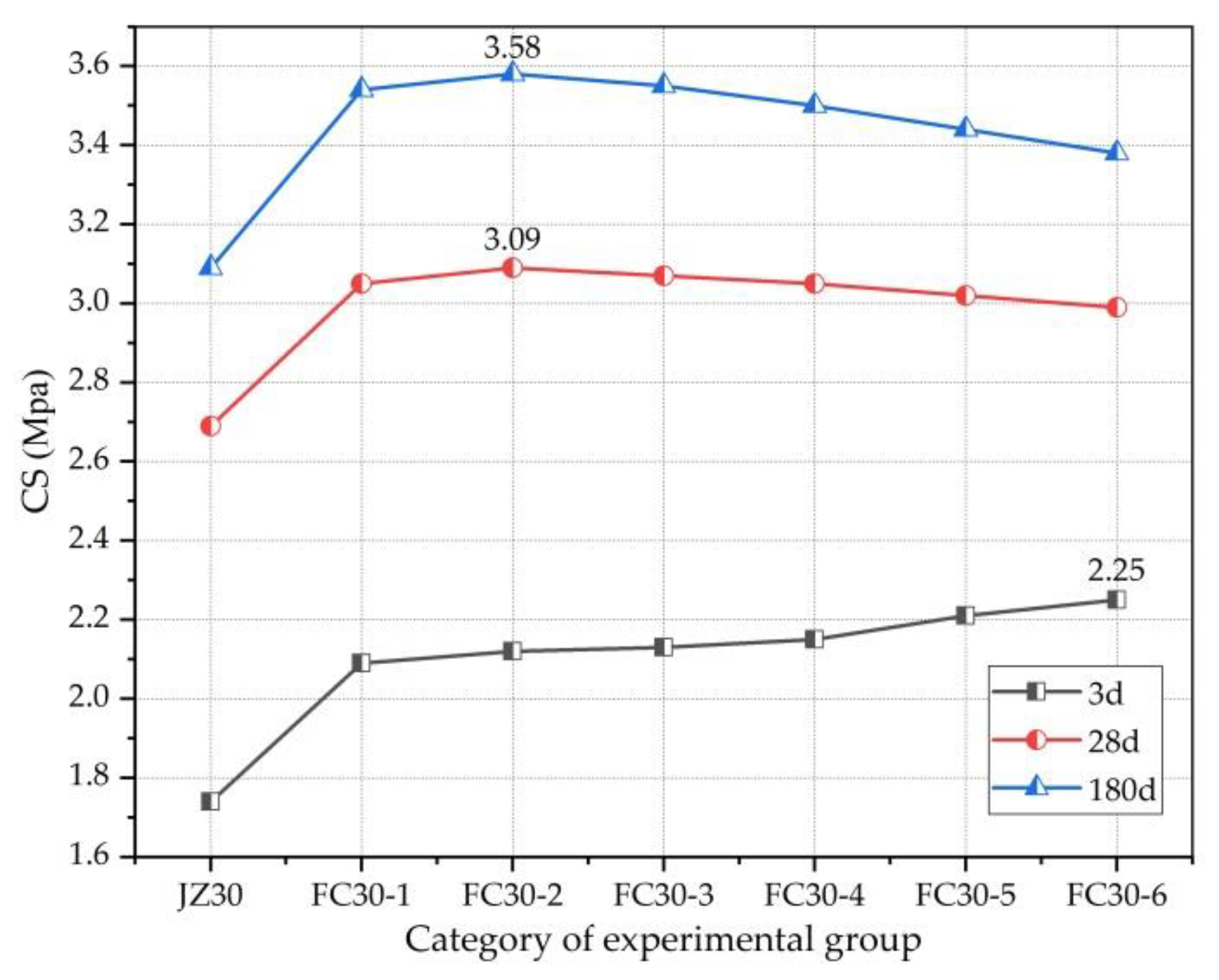

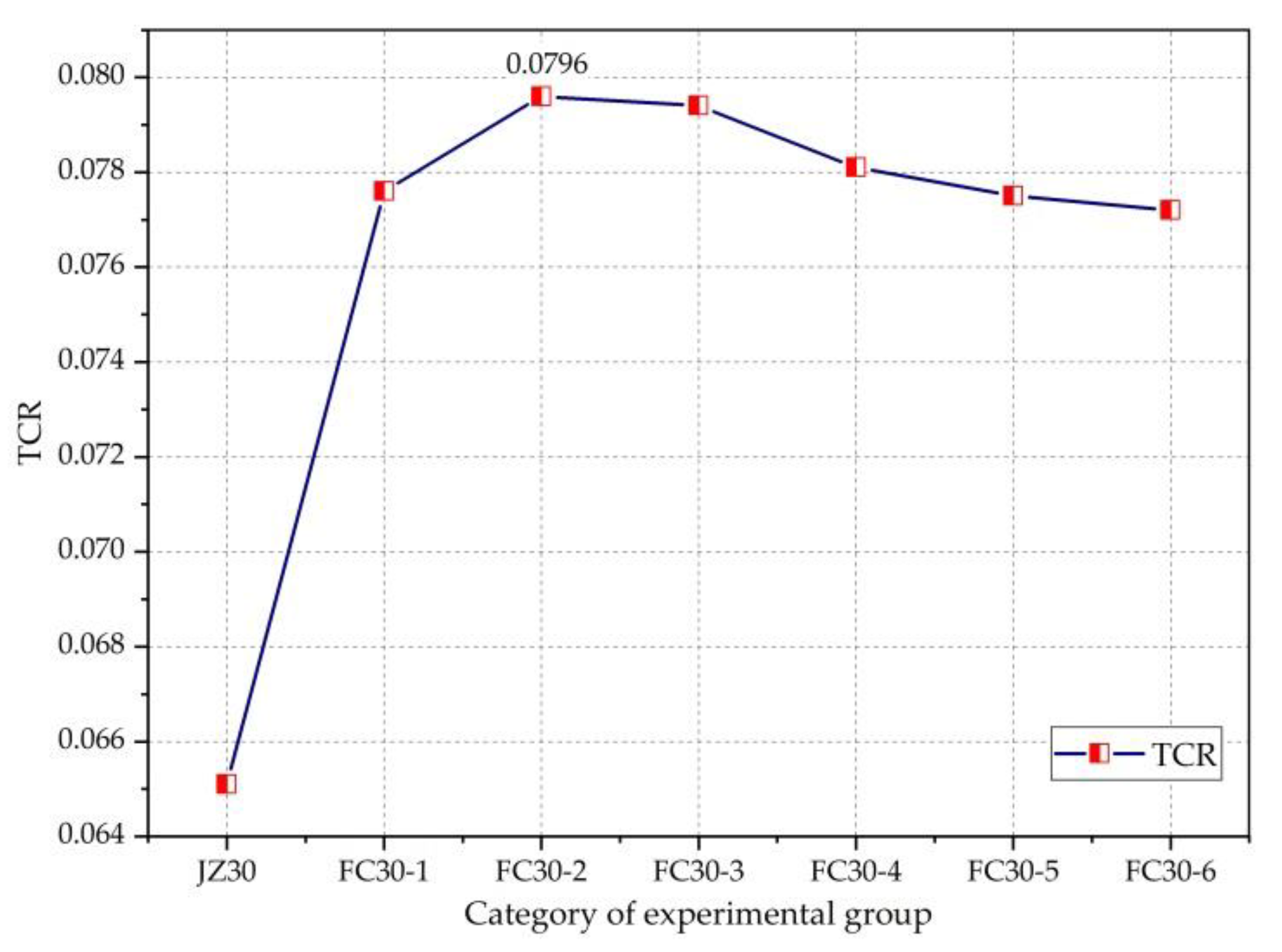
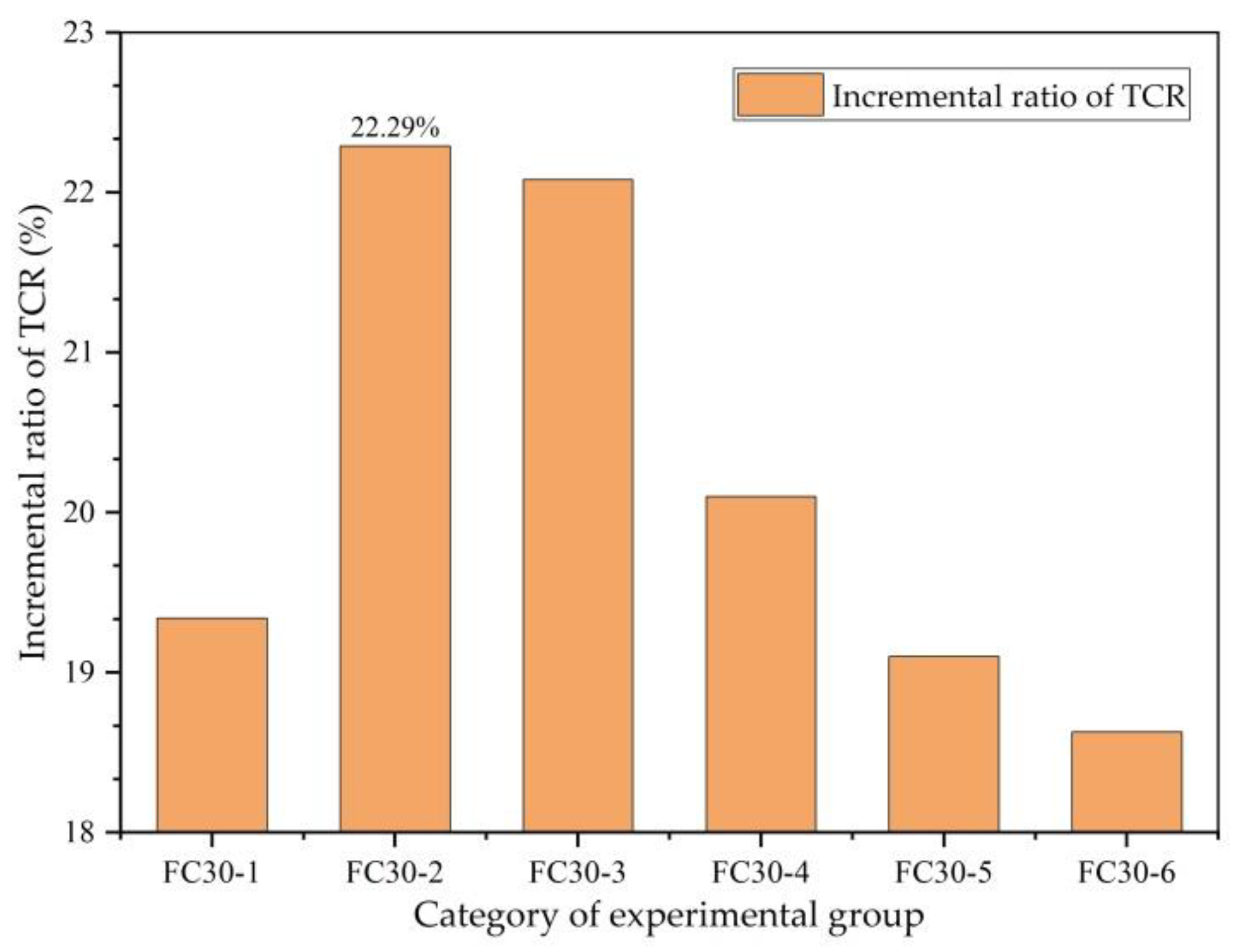
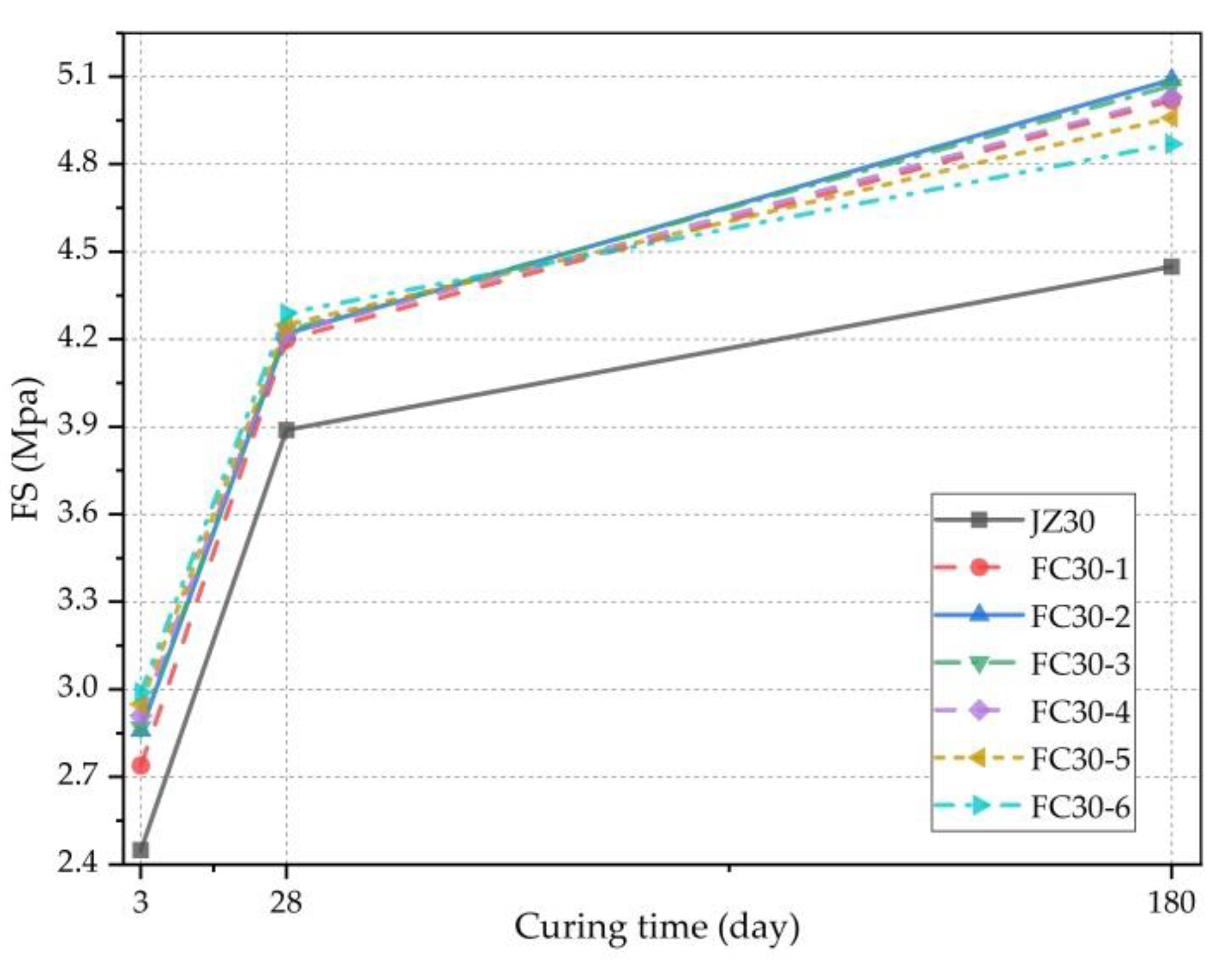
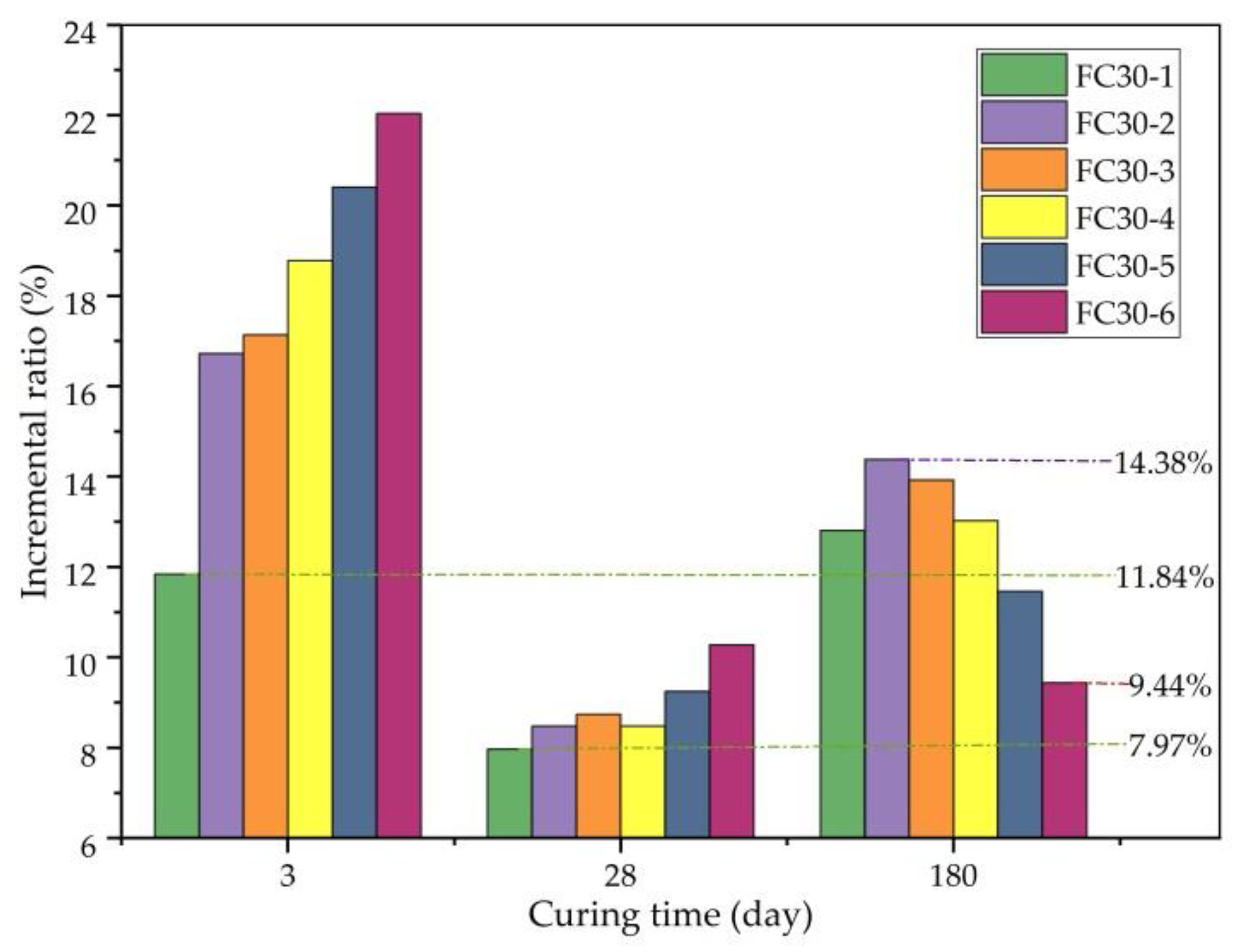

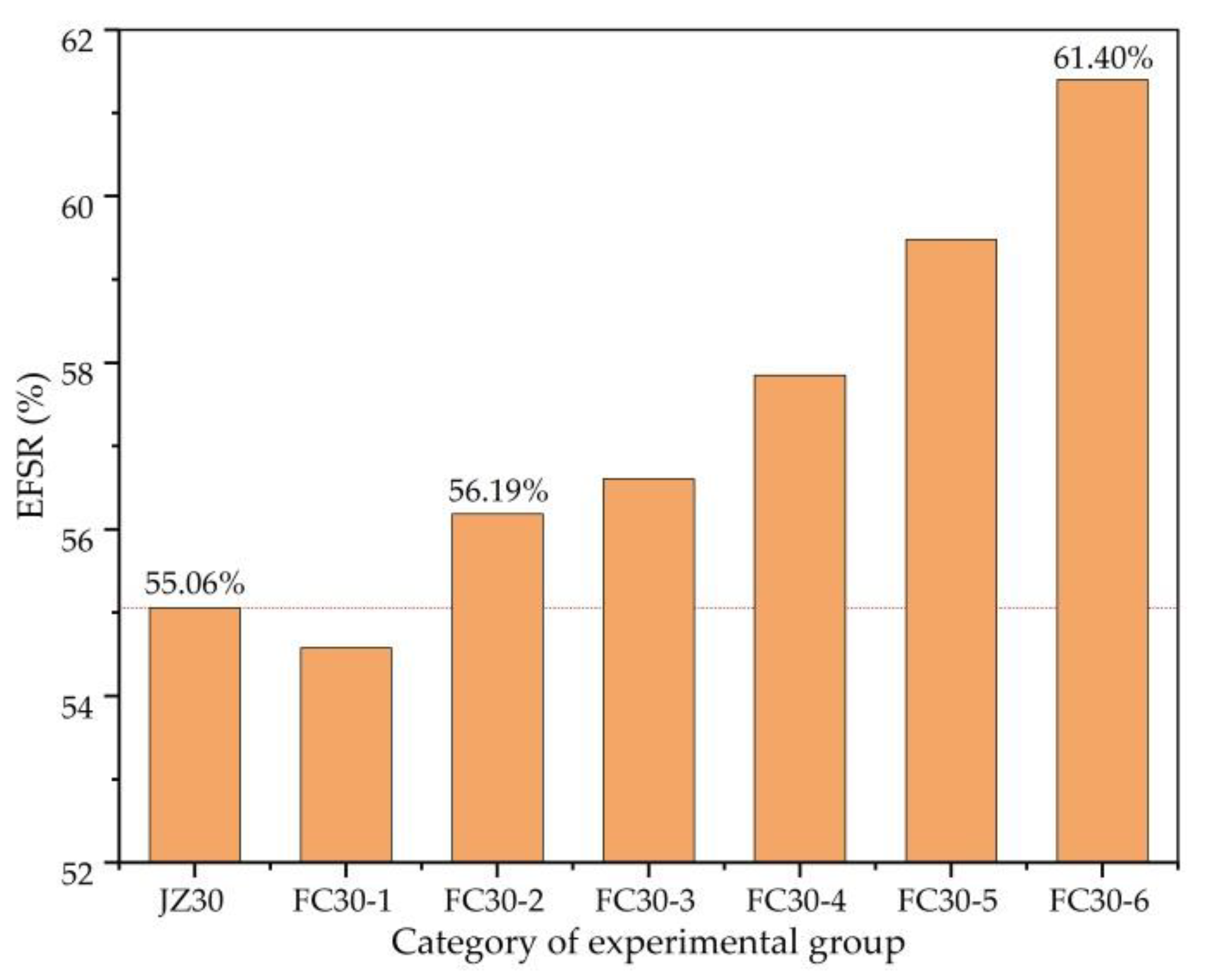
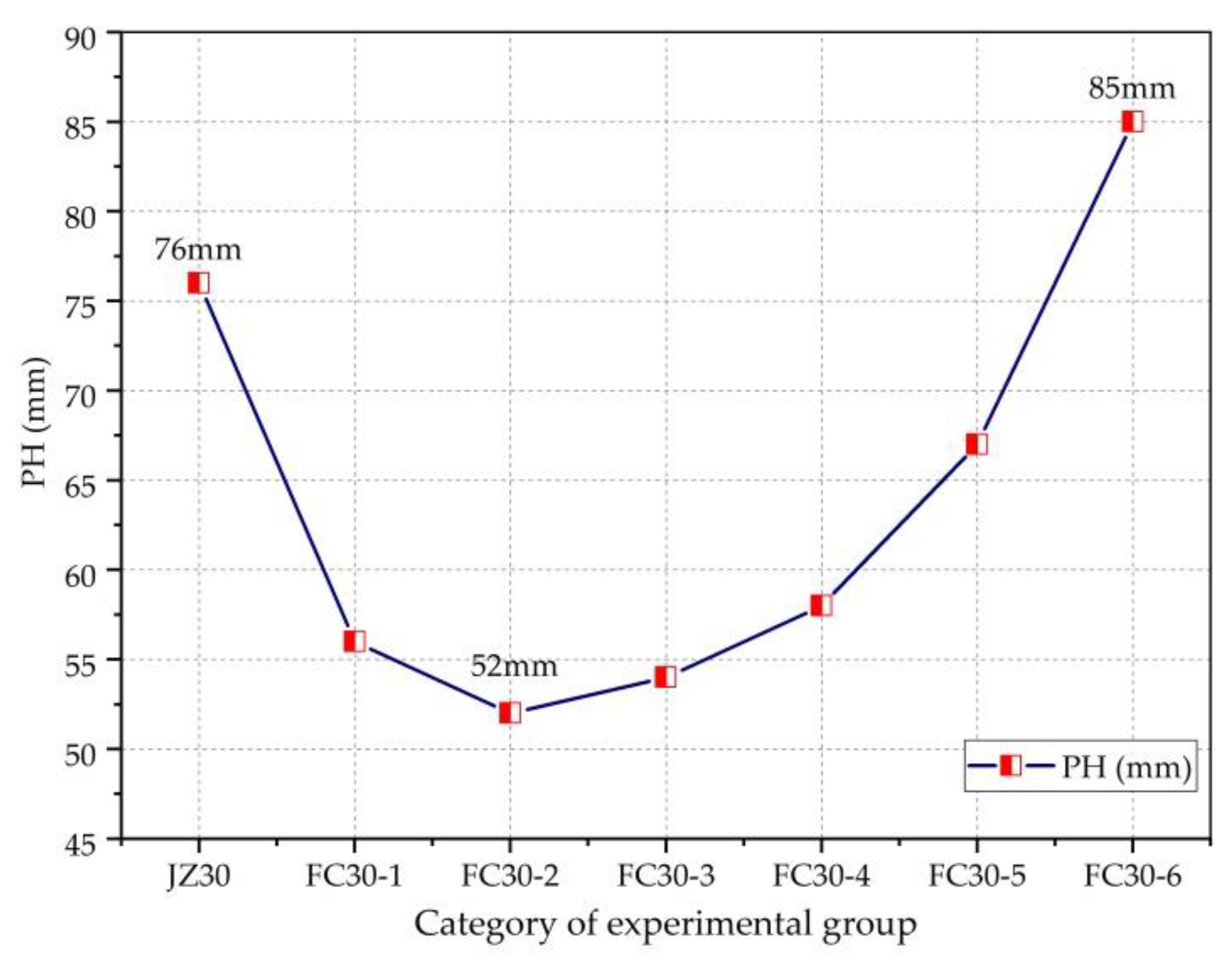
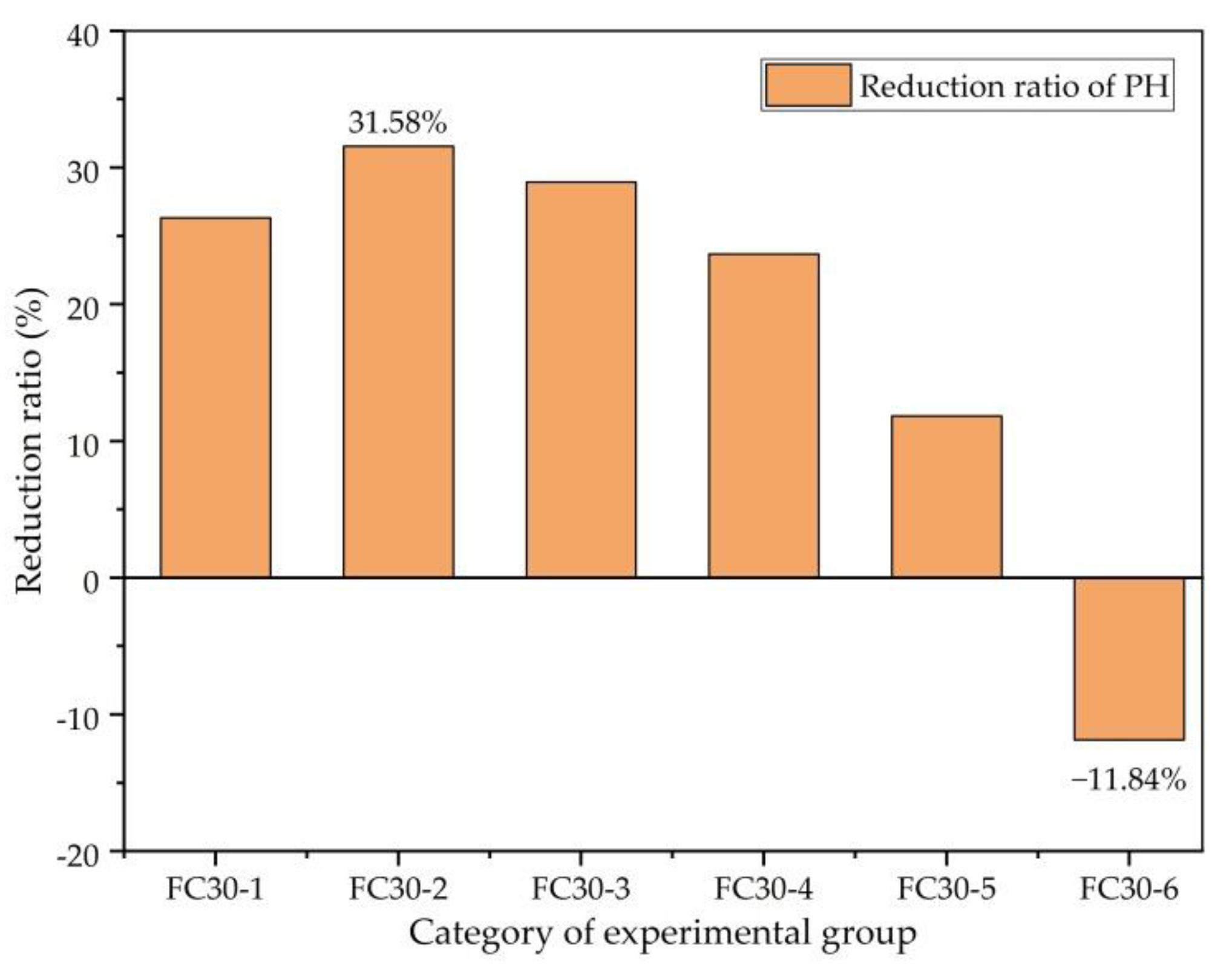
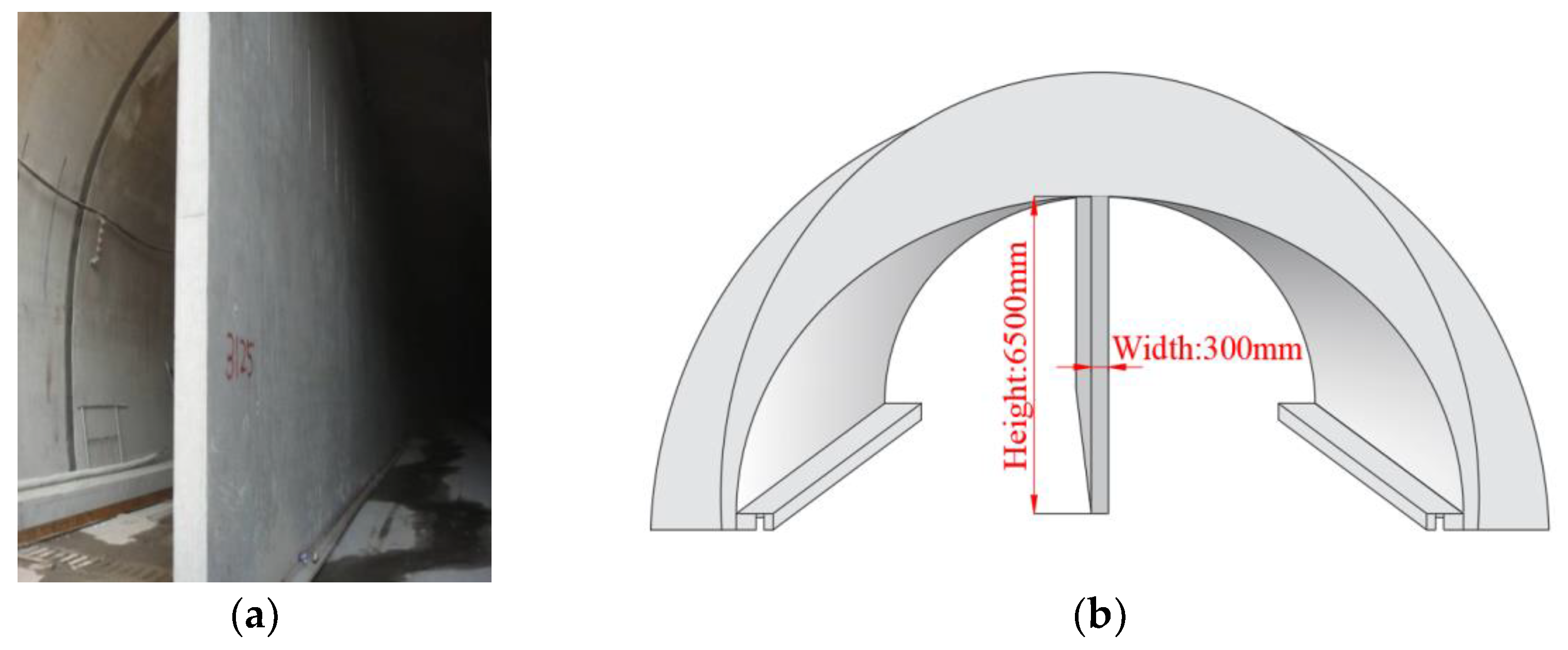

| Chemical Composition | SiO2 | Na2O | CaO | Al2O3 | ZrO2 | TiO2 |
|---|---|---|---|---|---|---|
| Content (%) | 62.0 | 14.8 | 5.6 | 0.8 | 16.7 | 0.1 |
| Species | Length (mm) | Equivalent Diameter (µm) | Fracture Strength (MPa) | Elongation at Break (%) | Modulus (GPa) | Melting Point (°C) |
|---|---|---|---|---|---|---|
| HD | 12 | 14 | 1700 | 3.6 | 72 | 1580 |
| HP | 36 | 700 | 1700 | 3.6 | 72 | 1580 |
| Serial Number | C30 Cement (kg/m3) | Sand (kg/m3) | Stone (kg/m3) | ARGF Content (kg/m3) | Water (kg/m3) | Water Reducing Agent | |
|---|---|---|---|---|---|---|---|
| HD | HP | ||||||
| JZ30 | 370 | 758 | 1047 | 0 | 0 | 185 | 1.8% |
| FC30-1 | 370 | 758 | 1047 | 0.6 | 2.5 | 185 | 2.0% |
| FC30-2 | 370 | 758 | 1047 | 0.6 | 5 | 185 | 2.0% |
| FC30-3 | 370 | 758 | 1047 | 0.6 | 7.5 | 185 | 2.0% |
| FC30-4 | 370 | 758 | 1047 | 0.6 | 10 | 185 | 2.0% |
| FC30-5 | 370 | 758 | 1047 | 0.6 | 12.5 | 185 | 2.0% |
| FC30-6 | 370 | 758 | 1047 | 0.6 | 15 | 185 | 2.0% |
| Project | Curing Time (d) | Experimental Group Category | ||||||
|---|---|---|---|---|---|---|---|---|
| JZ30 | FC30-1 | FC30-2 | FC30-3 | FC30-4 | FC30-5 | FC30-6 | ||
| CS | 3 | A B C | A B C | A B C | A B C | A B C | A B C | A B C |
| 28 | A B C | A B C | A B C | A B C | A B C | A B C | A B C | |
| 180 | A B C | A B C | A B C | A B C | A B C | A B C | A B C | |
| TS | 3 | A B C | A B C | A B C | A B C | A B C | A B C | A B C |
| 28 | A B C | A B C | A B C | A B C | A B C | A B C | A B C | |
| 180 | A B C | A B C | A B C | A B C | A B C | A B C | A B C | |
| FS | 3 | A B C | A B C | A B C | A B C | A B C | A B C | A B C |
| 28 | A B C | A B C | A B C | A B C | A B C | A B C | A B C | |
| 180 | A B C | A B C | A B C | A B C | A B C | A B C | A B C | |
| IP | 28 | A B C | A B C | A B C | A B C | A B C | A B C | A B C |
| D E F | D E F | D E F | D E F | D E F | D E F | D E F | ||
| Crack Limiting Performance Level | Evaluation Criteria |
|---|---|
| Level 1 | |
| Level 2 | |
| Level 3 |
| Monitoring Range | Amcr/Afcr | η | Crack Limiting Performance Level |
|---|---|---|---|
| Ordinary concrete middle partition section (K35 + 325 ~ K35 + 345) | 1269.7 | 0.86 | Level 1 |
| G-GRC middle partition section (K35 + 345 ~ K35 + 365) | 177.2 |
Publisher’s Note: MDPI stays neutral with regard to jurisdictional claims in published maps and institutional affiliations. |
© 2021 by the authors. Licensee MDPI, Basel, Switzerland. This article is an open access article distributed under the terms and conditions of the Creative Commons Attribution (CC BY) license (http://creativecommons.org/licenses/by/4.0/).
Share and Cite
Wang, Q.; Song, H.; Li, Y.; Wang, F.; Hu, Z.; Lou, S.; Shi, Z. Experimental Study on the Performance of Graded Glass Fiber Reinforced Concrete (G-GRC) Based on Engineering Application. Materials 2021, 14, 1149. https://doi.org/10.3390/ma14051149
Wang Q, Song H, Li Y, Wang F, Hu Z, Lou S, Shi Z. Experimental Study on the Performance of Graded Glass Fiber Reinforced Concrete (G-GRC) Based on Engineering Application. Materials. 2021; 14(5):1149. https://doi.org/10.3390/ma14051149
Chicago/Turabian StyleWang, Qingbiao, Hongxu Song, Yue Li, Fuqiang Wang, Zhongjing Hu, Shumei Lou, and Zhenyue Shi. 2021. "Experimental Study on the Performance of Graded Glass Fiber Reinforced Concrete (G-GRC) Based on Engineering Application" Materials 14, no. 5: 1149. https://doi.org/10.3390/ma14051149
APA StyleWang, Q., Song, H., Li, Y., Wang, F., Hu, Z., Lou, S., & Shi, Z. (2021). Experimental Study on the Performance of Graded Glass Fiber Reinforced Concrete (G-GRC) Based on Engineering Application. Materials, 14(5), 1149. https://doi.org/10.3390/ma14051149








